
Clematis is a genus of about 380 species within the buttercup family, Ranunculaceae. Their garden hybrids and cultivars have been popular among gardeners, beginning with Clematis 'Jackmanii', a garden staple since 1862; more cultivars are being produced constantly. They are mainly of Chinese and Japanese origin.

Hyacinthus is a small genus of bulbous herbs, spring-blooming perennials. They are fragrant flowering plants in the family Asparagaceae, subfamily Scilloideae and are commonly called hyacinths. The genus is native predominantly to the Eastern Mediterranean region from the south of Turkey to the Palestine region, although naturalized more widely.

Hyacinthus orientalis, the common hyacinth, garden hyacinth or Dutch hyacinth, is a species of flowering plant in the family Asparagaceae, subfamily Scilloideae, native to southwestern Asia, southern and central Turkey, northwestern Syria, Lebanon and northern Palestine. It was introduced to Europe in the 16th century. It is widely cultivated everywhere in the temperate world for its strongly fragrant flowers which appear exceptionally early in the season, and frequently forced to flower at Christmas time.

Wisteria floribunda, common name Japanese wisteria, is a species of flowering plant in the family Fabaceae, native to Japan. Growing to 9 m (30 ft), Wisteria floribunda is a woody, deciduous twining climber. It was first brought from Japan to the United States in the 1830s. It is a common subject for bonsai, along with Wisteria sinensis.
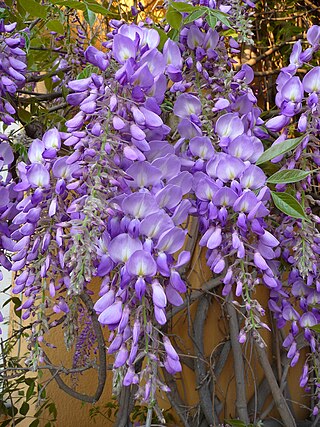
Wisteria sinensis, commonly known as the Chinese wisteria, is a species of flowering plant in the pea family, native to China, in the provinces of Guangxi, Guizhou, Hebei, Henan, Hubei, Shaanxi, and Yunnan. Growing 20–30 m (66–98 ft) tall, it is a deciduous vine. It is widely cultivated in temperate regions for its twisting stems and masses of scented flowers in hanging racemes, in spring.

Erica vagans, the Cornish heath or wandering heath, is a species of flowering plant in the family Ericaceae, native to Ireland, Cornwall, western France and Spain. It is a vigorous, spreading, evergreen heather reaching 75 cm (30 in) tall and wide, with pink flowers borne in racemes 14 cm (6 in) long in summer and autumn. The Latin specific epithet vagans literally means "wandering"; in this context it means "widely distributed".

Lavandula angustifolia, formerly L. officinalis, is a flowering plant in the family Lamiaceae, native to the Mediterranean. Its common names include lavender, true lavender and English lavender ; also garden lavender, common lavender and narrow-leaved lavender.

Cornus alba, the red-barked, white or Siberian dogwood, is a species of flowering plant in the family Cornaceae, native to Siberia, northern China and Korea. It is a large deciduous surculose (suckering) shrub that can be grown as a small tree. As a popular ornamental used in landscaping its notable features include the red stems in fall (autumn) through late winter, bright winter bark; and the variegated foliage in some cultivars, such as C. alba 'Elegantissima'. C. alba can grow to 3 m (10 ft) high, but variegated forms are less vigorous. For the brightest winter bark, young shoots are encouraged by cutting to the ground some older stems at the end of the winter, before leaves are open. The oval fruits are white, sometimes tinted blue.

Wallisia cyanea, or pink quill, is a species of plant of the genus Wallisia in the bromeliad family, native to the rainforests of Ecuador. An epiphytic perennial growing to 50 cm (20 in) high by 50 cm (20 in) wide, it has stemless rosettes of thin, recurved leaves and paddle-shaped spikes of 20 pink bracts with violet flowers, in spring and autumn.
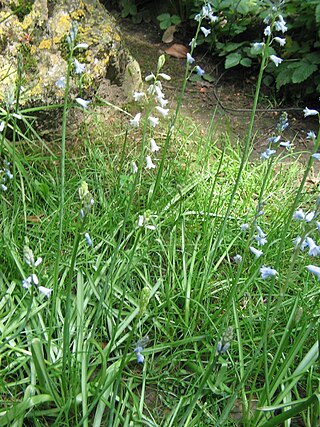
Brimeura is a genus of bulb-forming, monocotyledonous perennial plants. They have narrow leaves and bear bluebell-like flowers in Spring. Brimeura is treated in the family Asparagaceae, subfamily Scilloideae, tribe Hyacintheae, subtribe Hyacinthinae. It contains the following species

Ipheion uniflorum is a species of flowering plant, related to the onions, placed in the allium subfamily (Allioideae) of the Amaryllidaceae. It is known by the common name springstar, or spring starflower. Along with all the species of the genus Ipheion, some sources place it in the genus Tristagma, but research published in 2010 suggested that this is not correct. It is native to Argentina and Uruguay, but is widely cultivated as an ornamental and reportedly naturalized in Great Britain, France, Australia, New Zealand and the United States.
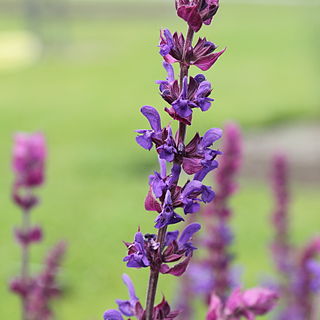
Salvia nemorosa, the woodland sage, Balkan clary, blue sage or wild sage, is a hardy herbaceous perennial plant native to a wide area of central Europe and Western Asia.

Crocus chrysanthus, the snow crocus or golden crocus, is a species of flowering plant of the Crocus genus in the family Iridaceae. Native to the Balkans and Turkey, it bears vivid orange-yellow bowl-shaped flowers. It has smaller corms and a smaller flower than the giant Dutch crocus, although it produces more flowers per corm than the latter. Its common name, "snow crocus", derives from its exceptionally early flowering period, blooming about two weeks before the giant crocus, and often emerging through the snow in late winter or early spring. The leaves are narrow with a silver central stripe. Height: 3–4 inches (7.6–10.2 cm).

Crocus sieberi, Sieber's crocus, also referred to as the Cretan crocus or snow crocus, is a plant of the genus Crocus in the family Iridaceae. A small, early blooming crocus, it easily naturalises, and is marked by a brilliant orange which is mostly confined to the stamens and style, fading through the bottom third of the tepal. It grows wild generally in the Balkans: Greece, especially in the island of Crete, Bulgaria, Albania and North Macedonia. There are four subtypes: sieberi (Crete), atticus, nivalis and sublimis. Its cultivars are used as ornamental plants. Height: 3–4 inches (7.6–10.2 cm).

Muscari aucheri, Aucher-Éloy grape hyacinth, is a species of flowering plant in the squill subfamily Scilloideae of the asparagus family Asparagaceae. It is a perennial bulbous plant, one of a number of species and genera known as grape hyacinths. Originally from Turkey, where it grows in grassy alpine areas, it is sometimes grown as an ornamental plant. The synonym M. tubergenianum may be found in the horticultural literature.
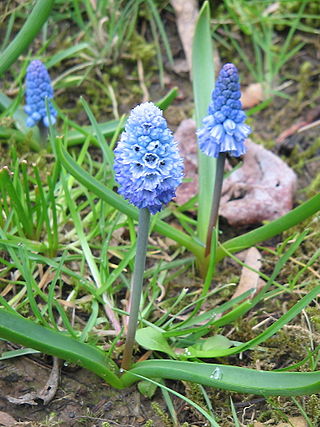
Pseudomuscari azureum, the azure grape hyacinth, is a species of flowering plant in the family Asparagaceae, native to Turkey. A bulbous perennial, it is grown in gardens for its spring flowers. The Latin specific epithet azureum means "bright blue", a reference to its flower colour.
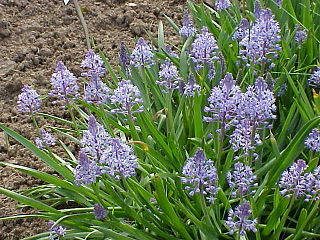
Scilla litardierei, the amethyst meadow squill or Dalmatian scilla, is a species of flowering plant in the family Asparagaceae. A bulbous perennial, with blue grape-hyacinth like flowers, blooming in late spring, much later than the more popular Siberian squill and later than Muscari which it resembles.
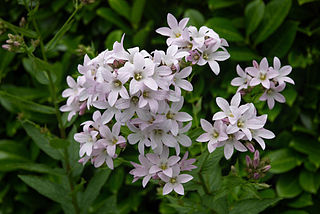
Campanula lactiflora, the milky bellflower, is a species of flowering plant in the genus Campanula of the family Campanulaceae, native to Turkey and the Caucasus. It is a medium-sized herbaceous perennial growing to 1.2 m, with narrow, toothed leaves 5–12 cm (2–5 in) long. Large conical clusters of open, star-shaped flowers are produced on branching stems in summer. In favourable conditions it will self-seed with variable results. The flowers are usually white or pale blue, but numerous cultivars have been developed for garden use, in a range of colours.
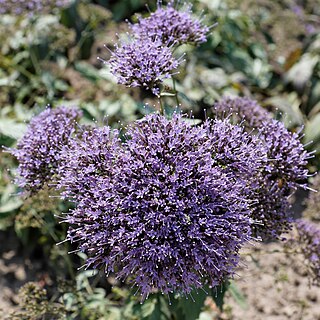
Trachelium caeruleum, common name blue throatwort, is a species of flowering plant in the family Campanulaceae native to the Mediterranean, where its native range includes Algeria, Morocco, Portugal, Spain, and Sicily. It has also become naturalized in a few areas, including New Zealand, the Azores, and parts of mainland Europe.
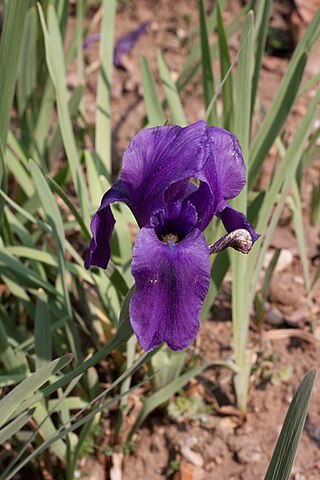
Iris hoogiana is a plant species in the genus Iris, it is also in the subgenus Iris and in the section Regelia. It is a rhizomatous perennial, from the grassy mountainsides of Turkestan. It has long green leaves, which are slightly purple at the base, and a long slender flowering stem. The flowers are blue, ranging from sky-blue to lavender blue and blue purple. It has orange or yellow beards. It is cultivated as an ornamental plant in temperate regions.























